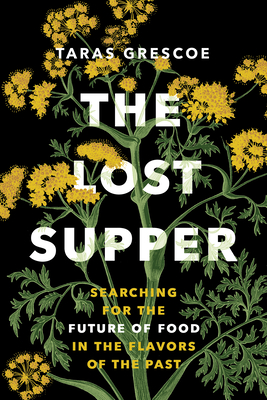“Searching for the Future of Food in the Flavors of the Past” is the instructive subtitle of this globe-trotting book of foodie exploration in the vein of A Cook’s Tour and The Omnivore’s Dilemma. With its firm grounding in history, it also reminded me of Twain’s Feast. Journalist Tara Grescoe is based in Montreal. Dodging Covid lockdowns, he managed to make visits to the homes of various traditional foods, such as the more nutritious emmer wheat that sustained the Çatalhöyük settlement in Turkey 8,500 years ago; the feral pigs that live on Ossabaw Island off of Georgia, USA: the Wensleydale cheese that has been made in Yorkshire for more than 700 years; the olive groves of Puglia; and the potato-like tuber called camas that is a staple for the Indigenous peoples of Vancouver Island.
One of the most fascinating chapters is about the quest to recreate “garum,” a fermented essence of salted fish (similar to modern-day Asian fish sauces) used ubiquitously by the Romans. Grescoe journeys to Cádiz, Spain, where the sauce is being made again in accordance with the archaeological findings at Pompeii. He experiences a posh restaurant tasting menu where garum features in every dish – even if just a few drops – and then has a go at making his own. “Garum seemed to subject each dish to the culinary equivalent of italicization,” he found, intensifying the existing flavours and giving an inimitable umami hit. I’m also intrigued by the possibilities of entomophagy (eating insects) so was interested in his hunt for water boatman eggs, “the caviar of Mexico”; and his outing to the world’s largest edible insect farm near Peterborough, Ontario.

Grescoe seems to be, like me, a flexitarian, focusing on plants but indulging in occasional high-quality meat and fish. He advocates for eating as locally as you can, and buying from small producers whose goods reflect the care taken over the raising. “Everybody who eats cheap, factory-made meat is eating suffering,” he insists, having compared an industrial-scale slaughterhouse in North Carolina with small farms of heritage pigs. He acknowledges other ecological problems, too, however, such as the Ossabaw hogs eating endangered loggerhead turtles’ eggs and the overabundance of sheep in the Yorkshire Dales leading to a loss of plant diversity. This ties into the ecological conscience that is starting to creep into foodie lit (as opposed to a passé Bourdain eat-everything mindset), as witnessed by Dan Saladino’s Eating to Extinction winning the Wainwright Prize (Conservation) last year.
Another major theme of the book is getting involved in the food production process yourself, however small the scale (growing herbs or tomatoes on a balcony, for instance). “With every home food-making skill I acquired, I felt like I was tapping into some deep wellspring of self-sufficiency that connected me to my historic—and even prehistoric—ancestors,” Grescoe writes. He also cites American farmer-philosopher Wendell Berry’s seven principles for responsible eating, as relevant now as they were in the 1980s. The book went a little deeper into history and anthropology than I needed, but there was still plenty here to hold my interest. Readers may not follow Grescoe into grinding their own wheat or making their own cheese, but we can all be more mindful about where our food comes from, showing gratitude rather than entitlement. This was a good Nonfiction November and pre-Thanksgiving read!
With thanks to Random Things Tours and Greystone Books for the proof copy for review.
Buy The Lost Supper from Bookshop UK [affiliate link]
I was delighted to be part of the blog tour for The Lost Supper. See below for details of where other reviews have appeared or will be appearing soon.

This sounds to me like a companion volume to Dan Saladino’s highly readable Eating to Extinction, which covers similar themes. I’ll look out for this – thanks.
LikeLiked by 1 person
Indeed, I imagine they’d make good companions, if coming at things from a slightly different angle. I’ve not read the Saladino.
LikeLike
Highly recommended.
LikeLike
Food preparation and consumption is such a complexly political issue that I always cringe a bit when food writers get prescriptive, but I like the flexitarian label and attitude—it’s how I try to cook in our household, mostly veggie with one or two meat dishes thrown in per week. Making vegetables delicious (to myself, a person with a huge sweet tooth and a strong natural tendency towards comfort eating) has been the culinary project of my adult life, and expanding the general idea of what there is out there to be eaten—within eco-conservationist reason—seems like a natural extension!
LikeLiked by 1 person
That seems a sensible approach. Like Michael Pollan once wrote, “Eat food. Not too much. Mostly plants.” We still struggle with cabbages, but otherwise are happy with our veg box-fuelled meals. On an unrelated note, I’ve sent you a time-sensitive e-mail and followed it up with a few messages on socials (sorry!), so have a look at that when you can.
LikeLike
Oh thank you for the head’s up! Sorry, I’m a bit vague about my emails sometimes. I’ll have a look.
LikeLike
Thanks for the blog tour support x
LikeLiked by 1 person
Dear Rebecca
Thanks for making us aware of this book. We’ll surely read it.
Have a happy weekend
The Fab Four of Cley
🙂 🙂 🙂 🙂
LikeLiked by 1 person
Great! I’m pleased it appeals.
LikeLike